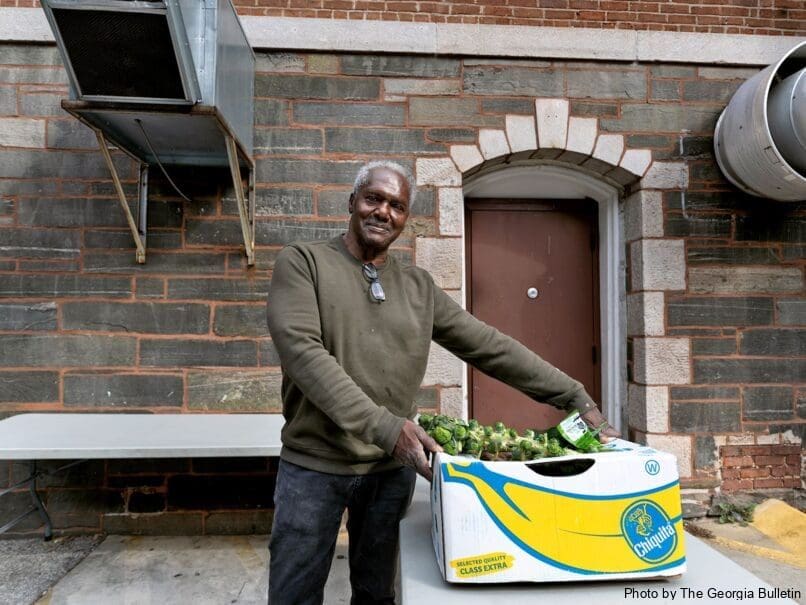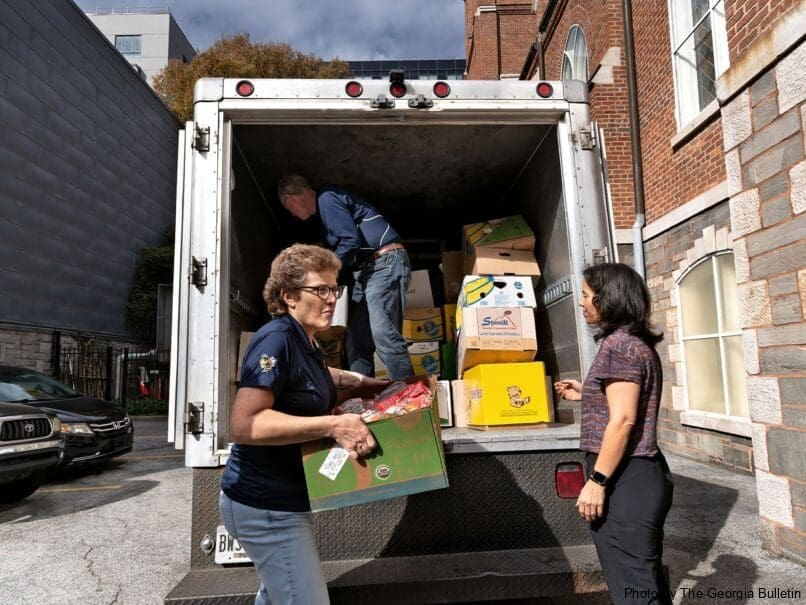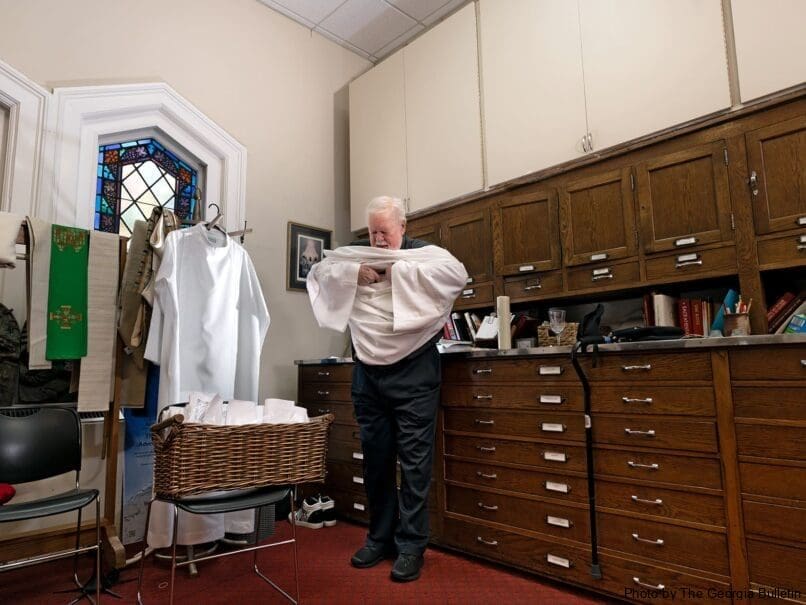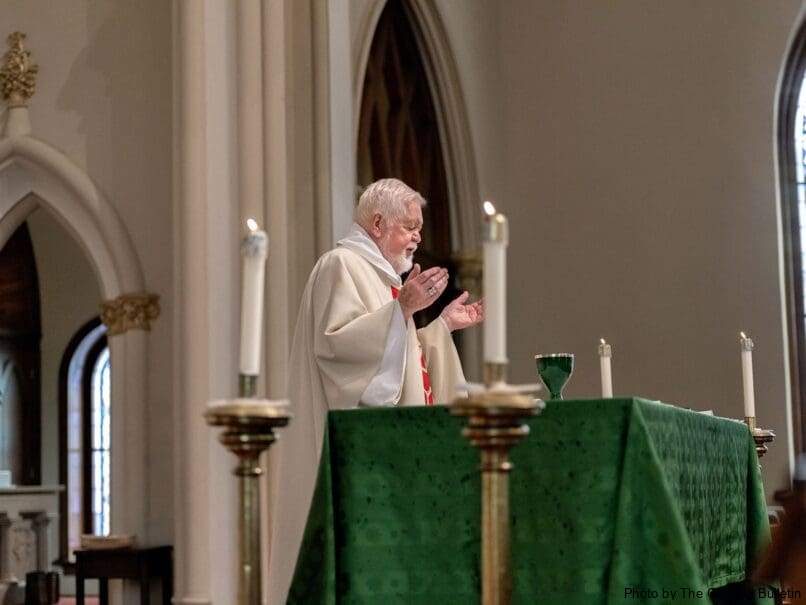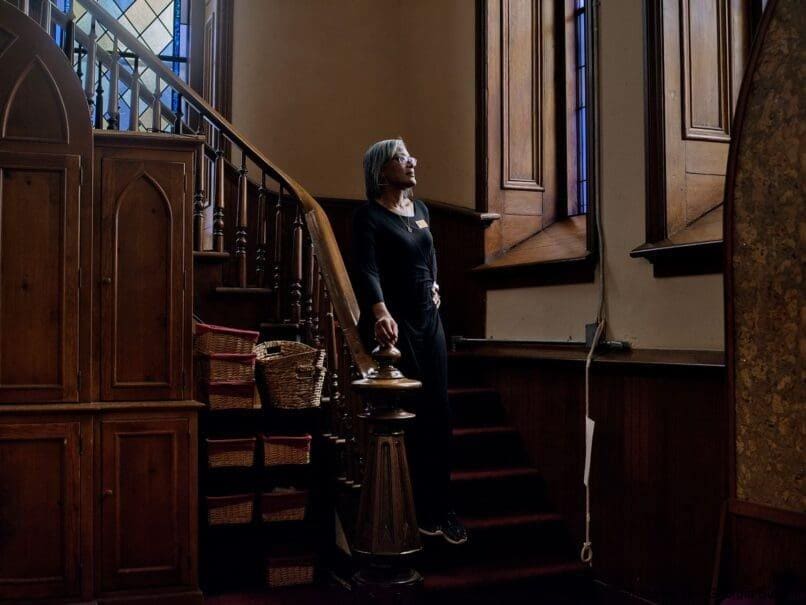Groundskeeper Carl Hall helps unload food donations at the Shrine of the Immaculate Conception in Atlanta. The church is celebrating 175 years. Photo by Johnathon Kelso
Atlanta
The welcoming tradition of Atlanta’s Shrine
By ANDREW NELSON, Staff Writer | Published December 1, 2023
ATLANTA—At the Shrine of the Immaculate Conception, it announces a “bold faith” lived by a “bold church.” And that’s how it’s been since it began.
During the Civil War, an Irish immigrant priest opened the downtown church to serve as a field hospital. It was a place for Union and Confederate soldiers wounded in battle to recuperate. Father Thomas O’Reilly continues to receive annual remembrances from the city of Atlanta for his outspoken role in saving civic and church buildings from the destructive fire that ravaged the city as the March to the Sea campaign began.
During the 1990s AIDS epidemic, the church opened its fellowship hall to the gay community suffering from the disease. On a weekly basis, dinner would be served to men who were sick. In response to complaints about the pastor’s outreach, two Atlanta archbishops came to meet the guests and prepare their plates of food. The outreach helped revitalize the church, making it known as one of the most inclusive and affirming parishes in the Archdiocese of Atlanta.
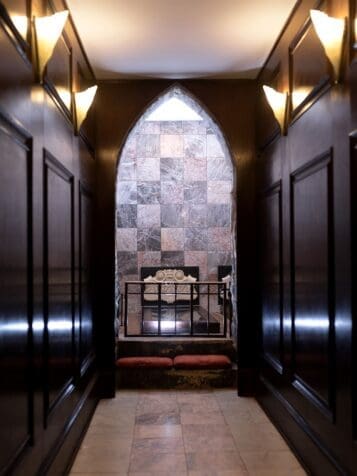
The tomb of Father Thomas O’Reilly photographed inside the crypt at the Shrine of the Immaculate Conception. The priest saved the church in the Civil War. Photo by Johnathon Kelso
The red-brick church sits blocks from the golden dome of Georgia’s capitol and Atlanta City Hall. It marked its 175 years of ministry on the corner block this year. It is the original Catholic church in this once rugged railroad town, serving the Irish immigrants who came here to build the tracks.
The Georgia Bulletin spent time at the Shrine to see what a day there is like.
08:30 a.m.
Jawanza Brown, 29, is packing more than 100 plastic grocery bags. The bags, along with a cup of coffee and a sandwich, are handed out as part of the meal service for people who are homeless and hungry. This outreach, known as the Sandwich Ministry, provides simple free meals for those in need who gather outside the church’s side entrance. Brown’s shopping cart, heavy with his bags and personal belongings, sits in a corner out of the way.
“I gravitated to the church. I just hand out some things in the morning,” said the Chicago native, who wears a keepsake around his neck from his seven years in the Marines.
Beyond the worn wooden door, a line of men carrying sleeping bags stretches down Martin Luther King Jr. Drive. This food service takes place during the weekdays, with larger meals available on Saturdays.
Inside, Susan Johnson prepared the donated sandwiches—peanut butter and jelly; ham and American cheese; turkey, and baloney. Johnson is a member of St. Paul United Methodist Church in nearby Grant Park. As soon as the door opens, the small room fills up. Sandwiches and bags fly into people’s hands. “It’s fast. There are some people who are very gracious,” said Johnson.
As the men and women accept the simple sandwiches, they cross paths with elegantly dressed wedding guests. A marriage ceremony is soon to begin in the sanctuary above them. The women in their dresses and the men in their suits looking for the restroom maneuver past others who are without shelter.
It takes about 45 minutes to reach the end of the meal line. Outside, Chris Rosse helps people. If folks cannot navigate the steps, he’ll take an order and retrieve the food.
He has worked for years with the Homeward Choir at the Shrine, connecting men who are homeless with job prospects and other things to help them move to stability. Rosse gets emotional talking about the men. He said the choir members, who have faced so much hardship, serve as role models for him.
Rosse’s high-end home goods showroom is at downtown’s AmericasMart. He admits he might have given an indifferent look to a homeless person in the past, but now he looks for friends.
“I’ll be walking along, and I’ll see somebody, we’ll connect on the streets now,” Rosse said.

A man waits to be served by the Sandwich Ministry at the Shrine of the Immaculate Conception. Photo by Johnathon Kelso
On these Fridays, Rosse, 61, said it gives him perspective. He shared how an older woman had a heartfelt moment hearing a familiar hymn playing and was drawn in, and now she has a role in the community handing out song sheets. That is the reward.
Rosse is not formally part of this faith community, as he worships at Holy Spirit Church in an affluent part of the city. He sees the goodness in both his well-to-do parish and the Shrine’s mission.
“I respect both worlds. I mean, they both have their purpose, their role in what we do as Catholics,” he said. “What I love about the Shrine is its openness and its willingness to just take in anyone and to support the community that’s around them and recognize what that community is about and to provide them the support.”
10:30 a.m.
Caitlyn Norton, 33, is sitting at the baby grand piano, playing the keys for an enthusiastic group of a dozen singers. The weekly gathering is known as the Community Choir—people who have come to get sandwiches and sit down in the lower hall out of the weather. She takes requests for crowd favorites like “Stand by Me,” “Wonderful World,” and “Go Tell It on the Mountain.
As a graduate student at Georgia State University, she recently performed a piece of classical sacred music sung in Latin. The Illinois native is here as part of a university fellowship assigned to the Shrine.
Despite the difference in musical styles, Norton, also a member of the Atlanta Master Chorale, said the contrast is not as stark as it may seem. She believes everyone discovers joy and community through music.
“It’s a slightly different bar of entry, but the spirit is still present,” Norton said.
In her work with the Homeward Choir, the goal is to get everyone singing. The choir starts with familiar tunes, creating a sense of comfort. Norton said, “We begin with a lot of stuff that people know. And then we might expand onto something that maybe someone’s never heard before.”
One song, “Joshua fought the Battle of Jericho,” has become a cherished favorite among the choir members.
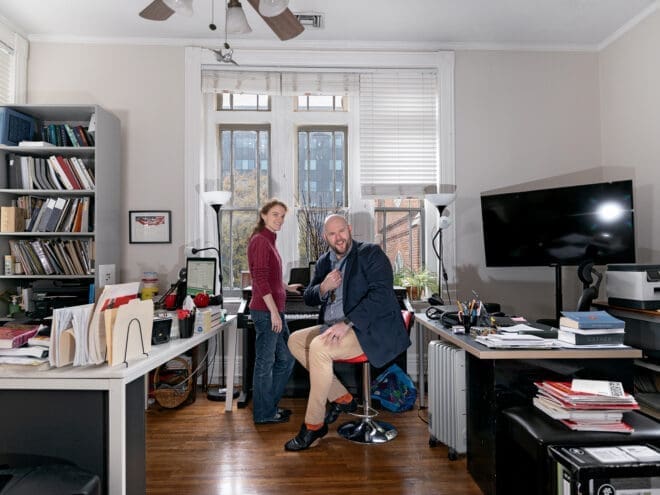
Associate Director of Music Caitlin Norton, left, and Director of Music Donal Noonan meet during office hours at the Shrine of the Immaculate Conception. Photo by Johnathon Kelso
When she gets up from the piano after about 30 minutes of practice, a line begins to form. Women and men earn a $10 gift card to spend at a nearby drugstore if they appear four times.
“I get just as much joy out of the Homeward Choir as I do out of Atlanta Master Chorale,” she said. “It just looks a little bit different.”
12:10 p.m.
Msgr. Henry Gracz walks from behind the white marble high altar, relying on a cane to keep his balance. His voice is soft, carried by the microphone, to the fewer than a dozen women and men scattered through the pews for Friday’s Mass.
It’s the feast of St. Elizabeth of Hungary, a 13th-century woman who dedicated herself to helping the poor. Reading from the missal, the priest prayed she continues to serve as a role model for believers as she “recognized and revered Christ in the poor.”
Lector Robert Goggin, 69, proclaimed the reading from the Book of Wisdom.
Except for the pandemic interruption, weekday Mass here became a regular ritual Goggin has followed since his father died in 2007.
“I had not been a very good Catholic, but his death left me kind of dumbfounded. And so, I started coming here,” he said.
When he worked near Woodruff Park, it was a seven-minute walk. But he left the bank position years ago. He lives in Roswell and attends St. Andrew Church, where he helps maintain the books for the St. Vincent de Paul ministry and writes checks to aid people in finding shelter. He travels to downtown Atlanta on Fridays.
“I come here because of Father Henry and because this church, particularly, embraces the best elements of Catholicism. They welcome immigrants and the poor and are non-judgmental about one’s sexual preferences,” he said. “Father Henry and his people here embrace, I think, the best elements of religious belief and the mission of Jesus, which is to welcome. That’s why I come here.”
At one time, the Shrine was at risk of closing due to falling attendance, and financial difficulties continued to hamper it through the 1980s when a fire destroyed most of the historic building. The parish has rebuilt a vibrant sacramental life with some 600 registered families living in more than 40 ZIP codes. In the past year, it’s celebrated 60 baptisms and 14 marriages. Its religious education program grew so much in the last couple of years a new staff member was hired to pass on the faith to the young people.
12:58 p.m.
Monsignor Henry Gracz sits down for lunch. His rescue dog, Taco, rests at his feet.
He’s been the spiritual leader here for 23 years. As pastor of the Shrine, he has continued to swing wide the church doors, fostering the Bashor Homeless Men’s Shelter, open five winter months in conjunction with Central Presbyterian Church next door, and St. Francis Table soup kitchen where hundreds are fed every Saturday. It supports a sister parish in Haiti. Church members host a booth at the annual Pride Festival.
In a broad conversation, he talked about leading one of the most gay-friendly parishes in the archdiocese, how reconciliation has been one of his touchstones as a priest, and the future.
“What 175 years means to me is that bold women and men, Catholic nuns who taught in school, street people, have given their spirits to sort of keep (the Shrine) going. It’s tangible,” he said.
As a priest for almost five decades, the native of Buffalo, New York, said he finds purpose in offering God’s healing love to marginalized people—from men who are homeless staying at the night shelter to Catholics who are gay.
He views his life’s work of ministry as listening without being judgmental. To new priests, he’d encourage them to embrace uncertainties and to be present to people.
“People don’t come for advice, they seek wisdom. And when you listen, you’re less willing to (give advice). You’re able to be more present, and you’re invited into their space as opposed to being on the outside and just sort of hearing stories,” he said.
“As people share their stories, we realize the core issue is not sexuality, but it’s humanity,” said Msgr. Gracz. “It’s that experience of the normality. The normality of people, whether they are straight or gay or Black or white, poor or rich, that people are people who’ve got a dignity about them.”
The parish makes people feel welcomed and affirmed, a tradition that goes back more than 30 years. It is carried on by the people who fill the pews—embracing the outcast and brokenhearted, says the priest, “by trying to greet every person, no matter how wounded, as somebody of value and, again, loved by God.”
